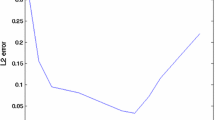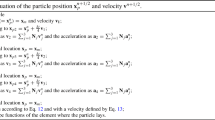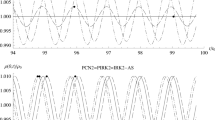Abstract
A meshless particle method based on an unconditionally stable time domain numerical scheme, oriented to electromagnetic transient simulations, is presented. The proposed scheme improves the smoothed particle electromagnetics method, already developed by the authors. The time stepping is approached by using the alternating directions implicit finite difference scheme, in a leapfrog way. The proposed formulation is used in order to efficiently overcome the stability relation constraint of explicit schemes. In fact, due to this constraint, large time steps cannot be used with small space steps and vice-versa. The same stability relation holds when the meshless formulation is applied together with an explicit finite difference scheme accounted for the time stepping. The computational tool is assessed and first simulation results are compared and discussed in order to validate the proposed approach.
Similar content being viewed by others
References
Ala, G., Francomano, E.: An improved smoothed particle electromagnetics method in 3D time domain simulations. Int. J. Numer. Model: Electronic Networks, Devices and Fields 25(4), 325–337 (2012)
Ala, G., Francomano, E.: SPEM modelling on HPC-GRID environment. ACES Appl. Comput. Electromagn. Soc. J. 27(3), 229-237 (2012)
Ala, G., Francomano, E., Tortorici, A., Spagnuolo, A.: A meshless approach for electromagnetic simulation of metallic carbon nanotubes. J. Math. Chem. 48(1), 72–77 (2010)
Ala, G., Di Blasi, G., Francomano, E.: A numerical meshless particle method in solving the magnetoencefalography forward problem. Int. J. Numer. Model: Electronic Networks, Devices and Fields (2012). doi:10.1002/jnm.1828
Belytschko, T., Krongauz, Y., Organ, D., Fleming, M. Krysl, P.: Meshless methods: an overview and recent developments. Comput. Methods Appl. Mech. Eng. 139, 3–47 (1996)
Cingoski, V., Miyamoto, N., Yamashita, H.: Element-free Galerkin method for electromagnetic field computations. IEEE Trans. Magn. 34(5), 3236–3239 (1998)
Cooke, S.J., Botton, M., Antonsen, T.M., Levush, B.: A leapfrog formulation of the 3-D ADI-FDTD algorithm. Int. J. Numer. Model: Electronic Networks, Devices and Fields 22, 187–200 (2009)
Duan, Y., Lai, S.J., Huang, T.: Coupling projection domain decomposition method and meshless collocation method using radial basis functions in electromagnetics. Prog. Electromagn. Res. Letters 5, 1–12 (2008)
Fang, J., Parriaux, A., Rentschler, M., Ancey, C.: Improved SPH methods for simulating free surface flows of viscous fluids. Appl. Numer. Math. 59(2), 251–271 (2009)
Fonseca, A.R., Mendes, M.L., Mesquita, R.C., Silva, E.J.: A 3-D radial point interpolation method for meshless time-domain modelling. J. Microw. Optoelectron. Electromagn. Appl. 8(1), 101S–113S (2009)
Fonseca, A.R., Viana, S.A., Silva, E.J., Mesquita, R.C.: Imposing boundary conditions in the meshless local Petrov-Galerkin method. IET Sci. Meas. Technol. 2(6), 387–394(2008)
Krohne, K., Gi-Ho, P., Ping, L.E.: A two-dimensional smoothed particle time-domain method. In: Asia Pacific Microwave Conference, art. no. 4958480 (2008)
Lai, S.J., Wang, B.Z., Duan, Y.: Meshless radial basis function method for transient electromagnetic computations. IEEE Trans. Magn. 44(10), 2288–2295 (2008)
Liu, G.R.: Mesh Free Methods: Moving Beyond the Finite Element Method. World Scientific Publishing (2003)
Liu, B., Liu, G.R.: Smoothed Particle Hydrodynamics—A mesh-free particle method. World Scientific Publishing (2003)
Liu, B., Liu, G.R.: Restoring particle consistency in smoothed particle hydrodynamics. Appl. Numer. Math. 56(1), 19–36 (2006)
Liu, B., Liu, G.R.: Smoothed particle hydrodynamics (SPH): an overview and recent developments. Arch. Comput. Methods Eng. 17(1), 25–76 (2010)
Liu, X., Wang, B.Z., Lai, S.: Element-free Galerkin method for transient electromagnetic field simulation. Microw. Opt. Technol. Lett. 50(1), 134–138 (2008)
Mendes, M.L., Pimenta, L.C.A., Mesquita, R.C., Silva, E.J., Santana, T.C.: Smoothed particle electromagnetics with boundary absorbing condition using perfectly matched layers. IET Conference Publications, (537 CP), pp. 164–165 (2008)
Mirzaei, D., Dehghan, M.: A meshless based method for solution of integral equations. Appl. Numer. Math. 60(3), 245–262 (2010)
Monaghan, J.J.: An introduction to SPH. Comput. Phys. Comm. 48, 89–96 (1988)
Monaghan, J.J., Lattanzio, J.C.: A refined particle method for astrophysical problems. Astron. Astrophys. 149, 135–143 (1985)
Monaghan, J.J.: Smoothed particle hydrodynamics. Annu. Rev. Astron. Astrophys. 30, 543–574 (1992)
Moussa, B.B.: On the convergence of SPH method for scalar conservation laws with boundary conditions. Methods Appl. Anal. 13(1), 29–62 (2006)
Namiki, T.: A new FDTD algorithm based on alternating-direction implicit method. IEEE Trans. Microwave Theor. Tech. 47(10), 2003–2007 (1999)
Park, G.H., Krohne, K., Bai, P., Er, P.L.: Applications of meshfree methods in electromagnetics. IET Conference Publications (537 CP), pp. 1–2 (2008)
Park, G.H., Krohne, K., Bai, P., Er, P.L.: Introduction to the smoothed particle hydrodynamics method in electromagnetics. Asia-Pacific Symposium on Electromagnetic Compatibility, pp. 582–585 (2008)
Sadiku, M.N.O.: Elements of Electromagnetics. Oxford University Press (2001)
Shanazari, K., Rabie, N.: A three dimensional adaptive nodes technique applied to meshless-type methods. Appl. Numer. Math. 59(6), 1187–1197 (2009)
Soares, D. Jr.: Numerical modelling of electromagnetic wave propagation by meshless local petrov-galerkin formulations. Comput. Model. Eng. Sci. 50(2), 97–114 (2006)
Sullivan, D.M.: Electromagnetic Simulation using the FDTD Method. IEEE press (2000)
Taflove, A., Hagness, S.: Computational Electrodynamics: The Finite-Difference Time-Domain Method. Artech House, Boston (2000)
Viana, S.A., Mesquita, R.C.: Moving least square reproducing kernel method for electromagnetic field computation. IEEE Trans. Magn. 35(3), 1372–1375 (1999)
Wang, J.G., Liu, G.R.: A point interpolation meshless method based on radial basis functions. Int. J. Numer. Methods Eng. 54, 1623–1648 (2002)
Yang, E., Mo, J. Liu, H., Xu, W., Wang, S.: Modification of the weak form to enforce electromagnetic field interface conditions in element-free Galerkin method. Int. J. Appl. Electromagn. Mech. 31(3), 127–145 (2009)
Yu, Y., Chen, Z.: A 3-D radial point interpolation method for meshless time-domain modelling. IEEE Trans. Microwave Theor. Tech. 57(8), 2015–2020 (2009)
Author information
Authors and Affiliations
Corresponding author
Rights and permissions
About this article
Cite this article
Ala, G., Francomano, E. A marching-on in time meshless kernel based solver for full-wave electromagnetic simulation. Numer Algor 62, 541–558 (2013). https://doi.org/10.1007/s11075-012-9635-1
Received:
Accepted:
Published:
Issue Date:
DOI: https://doi.org/10.1007/s11075-012-9635-1
Keywords
- Alternating directions implicit scheme
- Finite difference time domain
- Meshless methods
- Electromagnetic transient analysis




